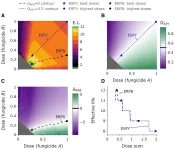(Press-News.org) BOSTON – New research from Boston Medical Center found that substance use disorders do not increase the likelihood of dying from COVID-19. Published in Substance Abuse: Research and Treatment, the study showed that the increased risk for severe COVID-19 in people with SUD that has been seen may be the result of co-occurring medical conditions.
Multiple large cohort studies from early in the pandemic have shown higher rates of hospitalization, intubation, and death from COVID-19 in those with SUD, while other studies found no association between SUD and COVID-19-related mortality or mixed results depending on substance use pattern. Given these conflicting data, the Centers for Disease Control and Prevention has classified persons with SUD as suggestive of higher risk for severe COVID-19. The goal of this study was to assess the association between SUD and inpatient COVID-19-related mortality.
“BMC is known for excellent clinical care and innovative research related to substance use disorder. Since the early days of the pandemic, BMC has also been a leader in the treatment of individuals with COVID-19, including persons with complex medical and social needs,” said first author Angela McLaughlin, MD, MPH, an infectious disease fellow at Boston Medical Center. “These findings showing a similar likelihood of COVID-19-related complications in hospitalized patients with and without SUD helps expand knowledge of the infectious complications of SUD.”
As BMC sees a high proportion of patients who use substances, it was an apt location for the study: almost 14% of the study population had SUD, exceeding the national average of 10.8% in people ages 18 or older. Researchers reviewed medical records of 353 adults without SUD and 56 adults with SUD admitted to Boston Medical Center early into COVID-19 pandemic and compared the likelihood of COVID-19 related complications between individuals with and without substance use disorders. They compared the relationship between COVID-19 and mortality, clinical complications, and resource utilization.
“Early in the pandemic, BMC developed protocols to closely monitor and quickly manage COVID-19-related complications in all hospitalized patients,” said senior author Sabrina Assoumou, MD, MPH, an infectious disease doctor at Boston Medical Center and Assistant Professor of Medicine at Boston University Chobanian & Avedisian School of Medicine. “The current findings suggest that such an approach might have benefited many patients, including individuals with substance use disorders.”
In this retrospective cohort study of patients admitted to a safety net hospital during the early phase of the COVID-19 pandemic, SUD was not associated with the primary outcome of COVID-19-associated inpatient mortality. The secondary analysis showed that those with and without SUD had similar COVID-19-related clinical complications, including secondary infections, renal failure requiring dialysis, acute liver injury, venous thromboembolism, cardiac complications, and the composite “any complications.” Of note, some clinical outcomes such as stroke were very uncommon overall. Likewise, there was no difference in resource utilization secondary outcomes between the two groups. In contrast to other studies, this found similar likelihoods of mechanical ventilation and ICU admission in patients with and without SUD. Although patients with SUD presented to the hospital earlier in their disease course, their total hospital length of stay was ultimately similar to patients without SUD. Insights such as these into the clinical complications and resource utilization patterns of patients with SUD and COVID-19 can help clinicians anticipate the trajectory of infection and healthcare needs in this vulnerable group.
There were some notable limitations to the study. The results are from a single site, which might limit generalizability of the findings despite the racial and ethnic diversity of the BMC patient population. Second, the data presented are from the earliest phase of COVID-19 in the United States, so trends may have differed with subsequent waves and as COVID-19 management strategies have evolved over time. Third, there were no specific controls for socioeconomic factors like medical insurance status or income level, as over 75% of the BMC patient population has public payer insurance (Medicare, Medicaid, or Children’s Health Insurance Program) or no insurance. Lastly, differences in COVID-19 outcomes between current versus past SUD could not be detected – this area would benefit from further research.
In conclusion, in this study of hospitalized individuals at an urban safety net hospital with a diverse patient population in the early days of the COVID-19 pandemic, inpatient mortality and morbidity between patients with and without SUD were similar. The findings provide a detailed evaluation of outcomes in a unique patient population that has been disproportionately impacted by COVID-19 and may provide beneficial insights for similar settings across the country. These results point away from SUD as an independent risk factor for severe COVID-19 and further suggest a focus on medical comorbidities to mitigate the effects of COVID-19. Additional studies are needed to further evaluate for differential outcomes in this high-risk population, particularly in an era of newer COVID-19-directed therapies.
###
About Boston Medical Center
Boston Medical Center is a leading academic medical center with a deep commitment to health equity and a proud history of serving all who come to us for care. BMC provides high-quality healthcare and wrap around support that treats the whole person, extending beyond our physical campus into our vibrant and diverse communities. BMC is advancing medicine, while training the next generation of healthcare providers and researchers as the primary teaching affiliate of Boston University Chobanian & Avedisian School of Medicine. BMC is a founding member of Boston Medical Center Health System, which supports patients and health plan members through a value based, coordinated continuum of care.
END
Embargoed for release: Friday, March 24, 2023, 12:00 PM ET
Key points:
The Environmental Protection Agency is currently considering new limits on PM2.5 air pollution. Implementing stronger limits would protect the health of all Americans, and in particular could reduce mortality rates among communities that are most threatened by air pollution—including Black and low-income Americans—by up to 7%.
Structural racism and poverty combine to change PM2.5 susceptibility, but structural racism may be more impactful when determining susceptibility.
Stronger air quality policies may also drive innovative ways to reduce the emission of heat-trapping gasses and could save ...
When someone smiles at us, we tend to smile back. On the other hand, if we spend time with someone who is mad or stressed, we end up absorbing these negative emotions. This tendency to align with the emotions of others is called emotional contagion. This basic form of empathy has been programmed in our brain for thousands of years and it is not difficult to get why. When there is a threat, this phenomenon allows fear to spread quickly, increasing the chances of survival. Besides, by mimicking emotions, we establish social bonds with others.
But this behavior is not exclusive to humans. New data from the Instituto Gulbenkian de Ciência (IGC) confirm that the ...
Fungicide application, while helpful in controlling plant diseases, has complicated limitations that may cost growers both peace of mind and quantity of yield. Plant pathogens which would otherwise be killed off by fungicides can evolve to avenge their dead siblings, developing resistance that renders the standard dose of fungicide application ineffective. To delay fungicide resistance, growers commonly use mixtures of fungicides to treat yield-limiting fungal diseases—based on extensive research outlining how to construct these mixtures. However, this research does not completely translate to the common, real-world scenario where one fungicide ...
Your circadian rhythm doesn’t just govern your sleeping schedule; it can also impact cancer development, diagnosis, and treatment. In a review paper publishing in the journal Trends in Cell Biology on March 24, researchers discuss the role of circadian rhythms in tumor progression and spread and describe how we could better time when patients are tested for cancer and when they receive therapies to improve diagnostic accuracy and improve treatment success.
“The circadian rhythm governs most of the cellular functions implicated in cancer progression, ...
Newly developed mRNA vaccines against Zika virus and HIV-1 produced strong antibody responses that transferred from pregnant rabbits to their offspring, researchers report March 24th in the journal Molecular Therapy. As noted by the authors, the results support further development of their vaccine platform, LIONTM/repRNA, for maternal and neonatal settings to protect against mother-to-child transmission of pathogens in animals and humans.
The recent success of mRNA vaccines in response to the COVID-19 pandemic is a catalyst for the development of mRNA vaccines targeting other infectious diseases. The U.S. Food and Drug Administration has authorized mRNA vaccines for children ...
A novel statewide incentive program intended to improve “warm hand-offs” from Pennsylvania emergency departments to opioid use disorder treatment programs is associated with a 50% improvement in the initiation of medication-assisted treatment in Medicaid-enrolled patients, according to new research from University of Pittsburgh, Howard University, Johns Hopkins University, University of Pennsylvania and Vital Strategies scientists. The finding, published today in JAMA Health Forum, points to a potential policy ...
About The Study: Marriage and children were associated with a greater earnings penalty for female physicians, primarily due to fewer hours worked relative to men, in this study of 95,000 U.S. physicians. Addressing the barriers that lead to women working fewer hours could contribute to a reduction in the male-female earnings gap while helping to expand the effective physician workforce.
Authors: Lucy Skinner, M.P.H., of the Geisel School of Medicine at Dartmouth in Hanover, New Hampshire, is the corresponding author.
To access the embargoed study: Visit ...
About The Study: In this study using data from 3,037 community-dwelling Medicare beneficiaries, food insecurity was prevalent and associated with a decline in executive function. Interventions and policies aiming to increase healthy food access or reduce food insecurity should be assessed for their impact on older adults’ cognitive outcome.
Authors: Boeun Kim, Ph.D., M.P.H., R.N., of Johns Hopkins University in Baltimore, is the corresponding author.
To access the embargoed study: Visit our For The Media website at this link https://media.jamanetwork.com/
(doi:10.1001/jamanetworkopen.2023.4674)
Editor’s ...
Lower electricity costs for consumers and more reliable clean energy could be some of the benefits of a new study by the University of Adelaide researchers who have examined how predictable solar or wind energy generation is and the impact of it on profits in the electricity market.
PhD candidate Sahand Karimi-Arpanahi and Dr Ali Pourmousavi Kani, Senior Lecturer from the University’s School of Electrical and Mechanical Engineering, have looked at different ways of achieving more predictable renewable energy with the ...
Higher alcohols (C2+ alcohols), which are important raw materials, have been used as the intermediates of valued products. They are also widely applied in various fields of fuel, food, fine chemicals, pharmaceuticals and energy.
With the gradual depletion of petroleum resources, the direct synthesis of higher alcohols from syngas has become a sustainable and potential process because of its wide source of raw materials and high atomic utilization. However, the low yield of higher alcohols restricted industrial application.
Recently, a research team led by Prof. SUN Jian and Prof. GE Qingjie from the Dalian Institute of Chemical Physics (DICP) of the Chinese Academy of Sciences (CAS) has ...

